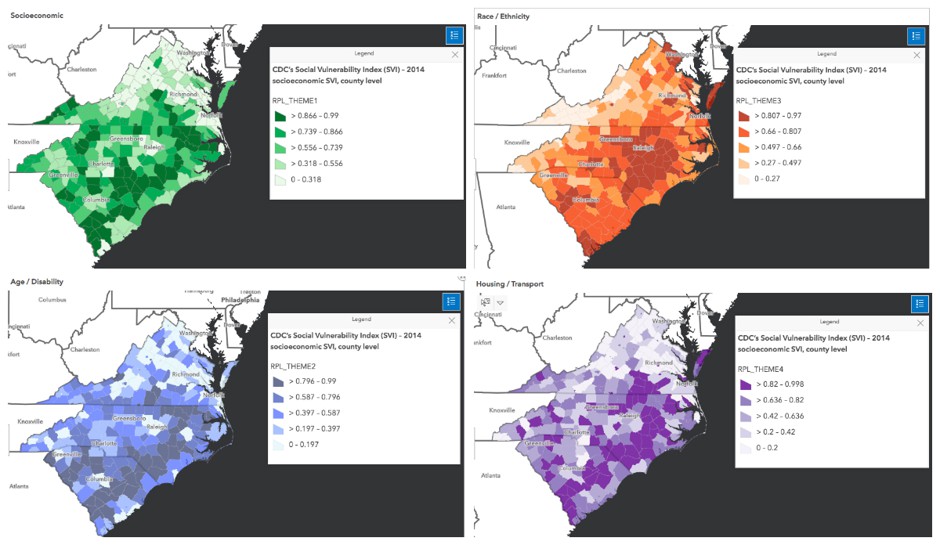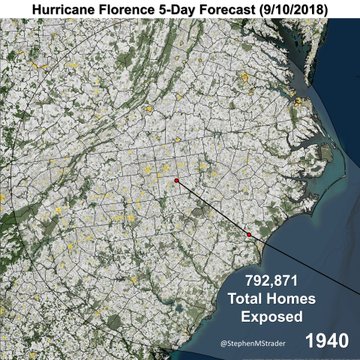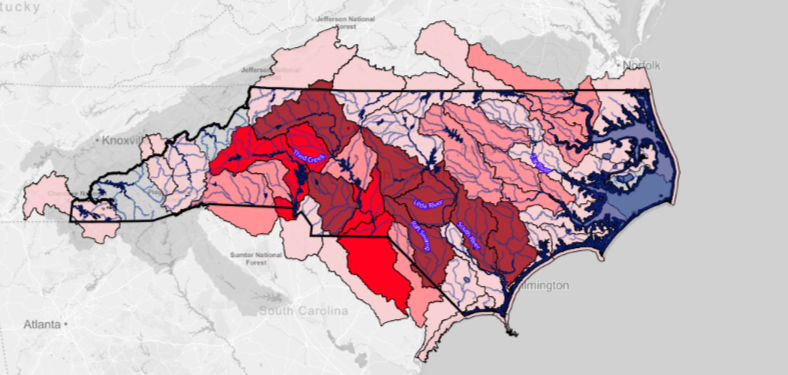A couple of interesting read about hurricanes from ProPublica and CityLab, the articles report on the cost to taxpayers to cover repeat insurance claims from wealthy home owners along the coast and expands on the environmental and socio-economic discrimination evident in the aftermath of disaster like Hurricane Florence.....
Hurricane Florence’s Surge Is Expected to Hit Homes That Already Cost the Government Millions
The storm is pummeling coastal towns that are battling rising sea levels and have been repeatedly bailed out by federal flood insurance.
Mapping the Unequal Burden of Hurricane Florence
Cameron Beccario is responsible for the Van Gogh of Hurricane Florence maps, created from his map of global weather conditions. While the Category 3 storm barreling toward the Carolinas won’t be pretty, Beccario’s map in all its data visualization glory is perhaps the most elegant depiction of Florence’s potential power. The screenshot below shows his weather data visualization mapped onto the earth.
A screenshot from Cameron Beccario’s weather map, which uses weather data from Global Forecast System (GFS), operated by the US National Weather Service. (earth.nullschool.net)
The reckoning, however, will not be the same for everyone in its path. Location is an obvious differentiator—but not the only one. Factors like socioeconomic status, age, whether a person has a disability, whether or not they own a car, and what languages they speak will also determine how easy or difficult it is to survive and recover from disasters like Florence.
More than 1 million people have been ordered to evacuate from the Carolinas and Virginia, but as in big storms prior, some will stay behind.
Direct Relief has created interactive maps that show the range of social vulnerability in Florence’s projected path (“social vulnerability” means the likelihood that a population will be disproportionately in need of support in an emergency). On the map below, warmer colors signify higher vulnerability; cooler colors, lower vulnerability.
Using the CDC’s social vulnerability index, Schroeder and his team also separately analyzed and mapped, at the county and census-tract level, four key factors: socioeconomics (income and wealth) shown in green, race/ethnicity (including language) shown in orange, household composition (age and disability) shown in blue, and housing/transport (including home and car ownership) shown in purple. Darker colors signify higher social vulnerability. (You can go to Direct Relief’s Hurricane Florence Social Vulnerability Dashboardand zoom in on specific areas.)
On Direct Relief’s maps, the coast is a lighter-colored strip, meaning lower social vulnerability. People living in coastal areas of the Carolinas generally tend to be more affluent and white, said Susan Cutter, who directs the Hazards and Vulnerability Research Institute at the University of South Carolina. Areas inland from the coast have more people with lower incomes and more members of minority groups. Although the coastline will see greater damage from the hurricane’s storm surge and strong winds, inland areas will likely face extensive flooding, especially if the system stalls overhead for a couple of days.
Rising sea levels due to climate change create even more risk, Cutter said, and recent development in coastal areas will add to the toll of Hurricane Florence. “The greater the development, the less open space there is for rainfall to percolate down into the soil because everything’s paved over,” Cutter said. “So where’s the water going to go? Well, it’s going to run off and create a flood.”
On Twitter, a disaster expert at Villanova University, Stephen Strader, also noted that development can increase vulnerability to disasters for humans and their possessions—a phenomenon called the expanding bull’s-eye effect. “Humans and their possessions are targets of these geophysical hazards like hurricanes and as populations grow and development spreads across the landscape, it creates disaster potential,” Strader told CityLab.
Also, Florence is headed toward the location of America’s second-largest hog farming industry, North Carolina, according to the U.S. Census of Agriculture. The Waterkeeper Alliance revealed the potential for water contamination from the state’s high number of animal farms with its 2016 maps using data on Concentrated Animal Feeding Operations (CAFOs).
Meanwhile, as Florence bears down, North Carolina, South Carolina, Virginia, Maryland, and D.C. are under states of emergency. As of Wednesday, maximum sustained winds were at 125 miles per hour. Up to 13-foot storm surges along the coast are expected as well as 20 to 30 inches of rainfall in coastal North Carolina, producing “catastrophic flash flooding,” according to the National Hurricane Center. And as these maps show, the brunt of the storm won’t be borne equally.














No comments:
Post a Comment